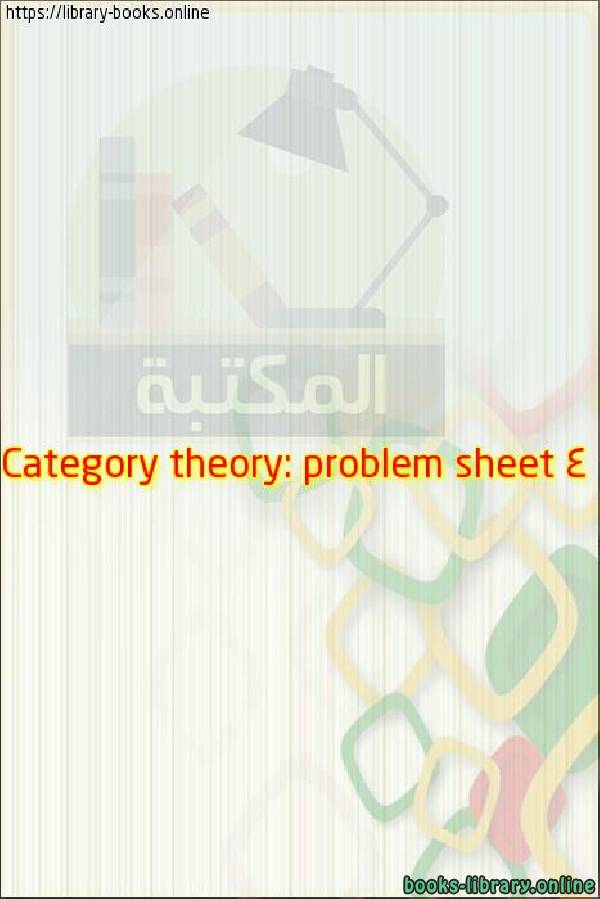📘 قراءة مذكّرة Category theory: problem sheet 4 أونلاين

Category theory is close to the perfect language. It can be used to describe many mathematical ideas, and see the relations between them, and their deeper structure. This is the first video in a course where we will carefully introduce the main ideas of category theory, and motivate them with lots of applications. This first video gives the definition of a category and give some motivation for studying the subject.

engineering mathematics course
engineering mathematics questions
engineering mathematics tutorial
engineering mathematics calculus
application of mathematics in engineering
higher engineering mathematics
engineering mathematics john bird
application of engineering mathematics in real life
الأشكال الهندسية في الرياضيات
تخصص هندسة رياضيات
الرياضيات الهندسية
الأشكال الهندسية
عالم الهندسة
الهندسة التحليلية
من مؤسس علم الهندسة
تعريف الأشكال الهندسية
In algebra, which is a broad division of mathematics, abstract algebra (occasionally called modern algebra) is the study of algebraic structures. Algebraic structures include groups, rings, fields, modules, vector spaces, lattices, and algebras. The term abstract algebra was coined in the early 20th century to distinguish this area of study from the other parts of algebra.
Algebraic structures, with their associated homomorphisms, form mathematical categories. Category theory is a formalism that allows a unified way for expressing properties and constructions that are similar for various structures.
Universal algebra is a related subject that studies types of algebraic structures as single objects. For example, the structure of groups is a single object in universal algebra, which is called variety of groups.
There are no essential prerequisites but familiarity with the basic theory of groups, rings, vector spaces, modules and topological spaces would be very useful, and other topics such as Algebraic Geometry, Algebraic Topology, Homological Algebra and Representation Theory are relevant. Category Theory also has links with Logic and Set Theory, but this course will not stress those links
Engineering mathematics is a branch of applied mathematics concerning mathematical methods and techniques that are typically used in engineering and industry. Along with fields like engineering physics and engineering geology, both of which may belong in the wider category engineering science, engineering mathematics is an interdisciplinary subject motivated by engineers' needs both for practical, theoretical and other considerations outwith their specialization, and to deal with constraints to be effective in their work.
الرياضيات الهندسية هي فرع من الرياضيات التطبيقية المتعلقة بالطرق والتقنيات الرياضية التي تستخدم عادة في الهندسة والصناعة. إلى جانب مجالات مثل الفيزياء الهندسية والجيولوجيا الهندسية ، وكلاهما قد ينتمي إلى فئة علوم الهندسة الأوسع ، تعد الرياضيات الهندسية موضوعًا متعدد التخصصات يحفزه احتياجات المهندسين للاعتبارات العملية والنظرية وغيرها من الاعتبارات خارج تخصصهم ، والتعامل مع القيود لتكون فعالة في عملهم.
Historically, engineering mathematics consisted mostly of applied analysis, most notably: differential equations; real and complex analysis (including vector and tensor analysis); approximation theory (broadly construed, to include asymptotic, variational, and perturbative methods, representations, numerical analysis); Fourier analysis; potential theory; as well as linear algebra and applied probability, outside of analysis. These areas of mathematics were intimately tied to the development of Newtonian physics, and the mathematical physics of that period. This history also left a legacy: until the early 20th century subjects such as classical mechanics were often taught in applied mathematics departments at American universities, and fluid mechanics may still be taught in (applied) mathematics as well as engineering departments.[1]
The success of modern numerical computer methods and software has led to the emergence of computational mathematics, computational science, and computational engineering (the last two are sometimes lumped together and abbreviated as CS&E), which occasionally use high-performance computing for the simulation of phenomena and the solution of problems in the sciences and engineering. These are often considered interdisciplinary fields, but are also of interest to engineering mathematics.[2]
Specialized branches include engineering optimization and engineering statistics.
Engineering mathematics in tertiary education typically consists of mathematical methods and models courses
تاريخيا ، تتكون الرياضيات الهندسية في الغالب من التحليل التطبيقي ، وأبرزها: المعادلات التفاضلية ؛ التحليل الحقيقي والمعقد (بما في ذلك تحليل المتجه والموتر) ؛ نظرية التقريب (يتم تفسيرها على نطاق واسع ، لتشمل الطرق المقاربة والمتغيرة والاضطرابات والتمثيلات والتحليل العددي) ؛ تحليل فورييه؛ النظرية الكامنة وكذلك الجبر الخطي والاحتمال التطبيقي خارج التحليل. كانت مجالات الرياضيات هذه مرتبطة ارتباطًا وثيقًا بتطور فيزياء نيوتن والفيزياء الرياضية في تلك الفترة. ترك هذا التاريخ أيضًا إرثًا: حتى أوائل القرن العشرين تم تدريس موضوعات مثل الميكانيكا الكلاسيكية في كثير من الأحيان في أقسام الرياضيات التطبيقية في الجامعات الأمريكية ، وقد لا يزال يتم تدريس ميكانيكا الموائع في الرياضيات (التطبيقية) وكذلك أقسام الهندسة.
سنة النشر : 2019م / 1440هـ .
حجم الكتاب عند التحميل : 26.2 كيلوبايت .
نوع الكتاب : pdf.
عداد القراءة:
اذا اعجبك الكتاب فضلاً اضغط على أعجبني و يمكنك تحميله من هنا:

شكرًا لمساهمتكم
شكراً لمساهمتكم معنا في الإرتقاء بمستوى المكتبة ، يمكنكم االتبليغ عن اخطاء او سوء اختيار للكتب وتصنيفها ومحتواها ، أو كتاب يُمنع نشره ، او محمي بحقوق طبع ونشر ، فضلاً قم بالتبليغ عن الكتاب المُخالف:
 قبل تحميل الكتاب ..
قبل تحميل الكتاب ..
يجب ان يتوفر لديكم برنامج تشغيل وقراءة ملفات pdf
يمكن تحميلة من هنا 'http://get.adobe.com/reader/'


 منصّة المكتبة
منصّة المكتبة